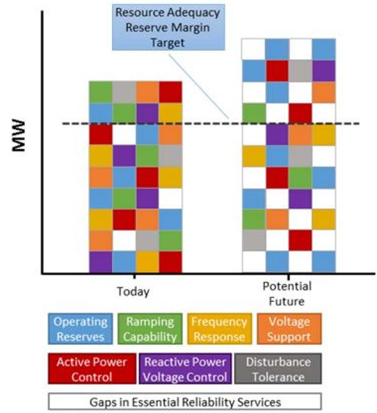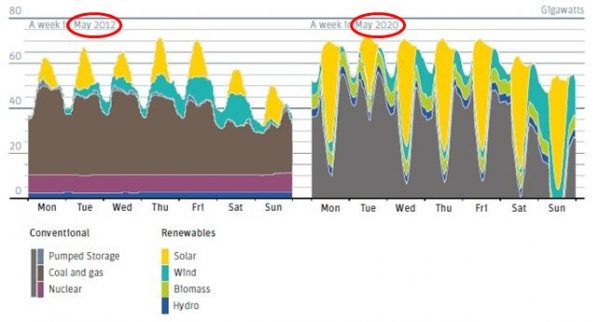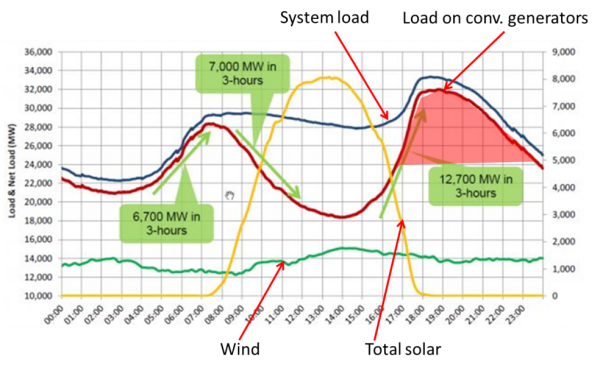
By William F. Kaewert, SENS
Introduction
The demand for onsite generation has historically been driven by the risk of local or regional power outage typically caused by bad weather such as hurricane or ice storm. The bulk power grid is also susceptible to cyber attacks, physical assaults on critical facilities and severe damage from both deliberate and natural electromagnetic pulses. These risks are significant and will be discussed in a subsequent article. The purpose of this article is to highlight why traditional fossil-fueled onsite generating systems are likely to proliferate and become substantially more valuable to their owners as renewable generation increases its share of the bulk US electric power supply.
Even without the impact of renewable power generation, the U.S power grid has in recent years become increasingly fragile. Grid power interruptions have been increasing in both frequency and duration. According to US Department of Energy data, “An aging infrastructure, combined with a growing population and more frequent extreme weather, are straining the electric grid. The annual average of outages has doubled every five years, which means the current five-year annual average is four times what it was fifteen years ago.”[1] Comparing 2000 to 2013, monthly average grid outages increased six-fold. The Brock article referenced in footnote 1 cites the US Department of Energy for the source data. Researchers at Lawrence Berkeley National Laboratory and Stanford University found that the total number of minutes customers go without power each year has been increasing over time.[2]
The increasing frequency and duration of outages indicate that today’s bulk electric power system is highly stressed. More stress and more outages mean that onsite power will become vital to new groups of users that were able to safety forego in the past. Today’s power grid stress, however, appears to be trivial compared with what is coming.
Renewable generation targets are frequently set by politicians without regard for bulk reliability concerns. Unfortunately, the benefits of more renewable energy are widely touted, but rarely presented with countervailing discussion of the unintended consequences to either the reliability or cost of electric power.

There are three significant power system issues related to renewables, all of which suggest that the on-site power generation (diesel or natural gas-powered generators) will become increasingly important in the future:
- The rush to renewable energy production will reduce grid reliability
- Variable renewable energy production will lead to increasingly volatile electricity prices
- Stubbornly high prices for energy storage mean that onsite generation will remain a viable customer-premises solution to electric reliability for a long time
The rush to renewable energy production will reduce grid reliability
Essential Reliability Services (ERSs) including voltage support, frequency response and other services shown nearby in Exhibit 1 are vital to stable and reliable operation of the power grid.[3] Voltage support, for example, prevents voltage collapse or system instability. Frequency response is necessary to maintain continuous load and resource balance by automatically responding to deviations from normal operating frequency. These services typically require that the bulk power system increase or decrease generation or shed load when necessary to maintain stable power grid operation.
The need for ERSs has historically been met with conventional generating systems such as steam turbines, hydroelectric turbines and combustion turbines. These conventional generating systems all share the property of having large rotating masses, the inertia of which enables them to ride through short-duration deviations in electric demand. In contrast, the rotating mass of wind turbines is relatively small, and solar systems offer zero rotating inertia. It is thus more difficult and costly to provide essential ERSs with renewables than it is with conventional generation.[4]
Conventional generating systems also share the property that their output is governed by man-made controls. When more output is needed in response to voltage or frequency sags, for example, these controls can typically increase the rate of energy input (opening valves to inject more combustion fuel, or admitting more water to boost hydroelectric turbine output). In contrast, the output from wind and solar generating systems is always outside of human control because the inputs are out of our control.
We obviously can’t make the sun shine more brightly, force passing clouds to part or keep the wind blowing for another few hours. In fact, unpredictable and variable output from renewable generation can therefore cause voltage and frequency variation rather than solving it, compounding the difficulty and expense of delivering Essential Reliability Services.
In other words, because conventional resources produce abundant ERSs, modest penetration of renewables poses negligible reliability risk. But because renewables do not readily provide ERSs, high penetration levels represent significant risks to power grid reliability.[5]
Exhibit 1 below from a North American Electric Reliability Corporation (NERC) report shows that increasing renewables penetration in the US bulk power system will reduce provision of Essential Reliability Services. The “Today” scenario below shows that there are fewer gaps (white blocks) in ERSs with largely conventional generation than there will be in the “Potential Future” when there are higher levels of variable generation.[6]
Exhibit 1: Potential Future Gaps in ERSs With
Increased Renewables Penetration

So, unpredictable variability in renewables output will very likely lead to gaps in Essential Reliability Services. Related to this is another issue. As the share of renewable power sources increase, so will the volatility of electricity flows on transmission and distribution (T&D) lines, as operators attempt to move power from where it’s produced to where it’s needed. It is important to understand that a key assumption behind renewable energy is that there exists a reliable and cost-effective means to move electric current from regions of abundance to areas of scarcity. Transmission bottlenecks will occur as the penetration rate of renewables continues to increase. The consequence of such bottlenecks will be lower reliability and higher costs of electricity.
Designers of our existing transmission and distribution systems, never designed the grid to move large quantities of electricity in response to the vagaries of changing weather. The new demands imposed by the siting of renewable energy sources long distances away from consumers could well cause more frequent and longer duration outages. A California Energy Commission fact sheet concedes that, “moving to 50 percent renewable energy (the state’s goal by 2030) could make balancing electricity demand and generation increasingly challenging at some times during the day and year.”[7]
As renewable energy production increases its share of the US market, what will the change in bulk power system reliability look like? While we can’t know for sure, there are indications that, as with most systemic changes, the change will be a tipping point rather a linear decay. Forecasts for Germany, which leads the US in renewable energy adoption, suggest that this tipping point might occur at the point where renewable energy production begins to regularly replace base load generation[8].
Exhibit 2: Renewable Energy in Germany in 2012 and 2020

Exhibit 2 nearby includes two scenarios. The left graphic illustrates a week of actual 2012 German power generation showing both renewable and non-renewable sources. The right graphic shows estimated power generation in 2020. The 2012 graphic show that solar output is very effective at satisfying much of the normal daily peak load. The 2012 scenario is nearly idea because base load systems continue running at relatively constant output, rather than facing large ramps, and renewable energy systems deliver output coincident with peak demand. The relationship in 2012 between conventional and renewable energy generation is symbiotic. Just as important, power flows over the T&D network are likely little different from the “conventional” generation world for which they were designed. The system appears to work very well when renewables only supply power at the margin, as they did in 2012.
In contrast, the forecast for 2020 is no longer symbiotic. Solar output has largely replaced base load fossil and nuclear generation – but for only a fraction of the average day. Unless this energy is both generated and consumed at each user’s site, which is highly unlikely, wild swings in power output and transmission system loading will occur. As this happens, suppliers and consumers will attempt to trade and move electric power over transmission pathways never designed for this task, which in turn will significantly challenge the German electric grid. As US renewable energy production reaches this same tipping point the reliability of North American power grids could well fall off the same proverbial cliff.
According to the German study referenced in Footnote 8, “[b]aseload power is incompatible with intermittent renewables […]. To complement renewables, we will need dispatchable power plants that can ramp up and down relatively quickly.” Onsite power meets this requirement perfectly, and will certainly be part of the solution to the problem of managing tomorrow’s power grid. Historically, onsite power has been an “insurance” product that mitigates risk of power outages. It is not difficult to envision a new future role for onsite generation, which is delivering value to its owner each day by curtailing grid power consumption and/or avoiding exorbitant time-of-day pricing by utilities.
Variable production will lead to volatile pricing
We intuitively understand that power, like any good, will be cheap when there is too much of it[9], and very expensive when it is in short supply. As with any economic good, the more abundant or scarce electricity is the more its price will vary. Time of day pricing is already a reality in some parts of the US. In Germany, variable renewable energy output has already resulted in such massive swings in the supply and price of energy that customers are sometimes paid to consume power[10]. The reverse is certainly true: when power is truly scarce the price will become exorbitant. We therefore reach the very logical conclusion that it would be wise to store power when it is abundant and cheap, and draw stored reserves down when grid power is scarce and costly.
One obvious solution would be to consume as much power as possible when it is cheap and then curtail usage when it is costly. While nearly all of us either are, or soon will, modifying our power consumption in response to market signals, all of us will reach a point where the prices demanded during peak times may become unaffordable. One solution to this problem will be to generate one’s own power during peak demand times.
Another obvious solution to the problem of large swings in supply and prices is energy storage. Unfortunately, energy storage is costly and may remain so for some time.
Stubbornly high prices for energy storage mean that onsite generation will remain a viable customer-premises solution to electric reliability for the foreseeable future
In a world where electricity is sometimes dirt cheap, and other times very costly, the logical solution would be “energy storage”. Plentiful storage would enable users to buy cheaply and either use their excess when power is expensive, or resell it to others. Unfortunately, although the cost of battery technology[11] continues to drop, the price of truly useful amounts of storage remains high, as shown in the following forecast for 2020 California.
Exhibit 3: Forecast California 2020[12]

The red line in Exhibit 3 nearby shows 2020 California’s so-called “duck” curve[13] of daily electrical production. Bulk power from solar generating systems peaks during mid-day, replacing a large portion of output from traditional generating sources. With regard to energy storage, the pink shaded area depicts the magnitude of energy storage California would need if it were to meet 100% of the evening peak demand with energy storage instead of generating in excess of the 24,000 MW (megawatts) value shown on the chart at about 4:30 PM. Starting at about 4:30 PM when solar output wanes, evening peak demand of ~35,000 MWH (megawatt-hours), represented by the light red hump, lasts from 4:30 PM until nearly midnight. At today’s energy storage cost of between $750,000 and $900,000 per MWH, the cost to California of this storage would range from $25 billion to $31 billion. To put this number in perspective, 35,000 MWH is double the entire 2015 global lithium-ion battery manufacturing capacity of 14,600 MWH.[14] The cost of this storage would represent more than half of California’s entire annual agricultural output of $54 billion.[15] Exacerbating the high capital cost is the fact that, because the lifetime of grid-scale batteries is only estimated at eight to ten years, the huge expense would recur.
Given this stubbornly high cost of storage, it seems likely that most of the evening peak demand in 2020 California will be met either with either variable generation or by compelling users to reduce demand through punitive pricing schemes. As this future of highly variable pricing unfolds, the return-on-investment of onsite generation resources likely only gets better with time.
Summary
A 2004 paper by Albert, Albert and Nakarado[16] concludes that “… vulnerability of the electric power grid is inherent to its organization and therefore cannot be easily addressed without significant investment.” The authors are clear that truly reliable operation is possible only by adopting distributed generation, where users or local communities generate their own power.
In recent years reliability of the US power grid has declined. We are actively accelerating this decline by replacing conventional generators that provide plentiful Essential Reliability Services with renewables that do not by themselves provide Essential Reliability Services. We are also accelerating this decline by tasking the grid with moving electricity from new and different sources of generation over pathways that were never meant to move large quantities of power. Even if we get really lucky and don’t suffer significant reliability problems or a big, long-duration blackout, the way we pay for electric power is sure to change. Time of day pricing is already a reality in parts of the US. The law of supply and demand says that as the percentage of total US power delivered by renewables increases the variation in time-of-day electricity pricing will only increase.
When considering electric grid reliability and almost certain increases in the volatility of electricity prices, three conclusions are clear about onsite power generation:
- The only way to guarantee power to critical systems will be to make it locally
- As time-of-day pricing volatility increases, the economics of onsite generation will only improve
- Onsite generation, today regarded as only an “insurance” product, will in the future provide new value by enabling its owner to avoid exorbitant time-of-day electricity prices
Footnotes
[1] Power Outages On The Rise Across The U.S.; Jordan Wirfs-Brock; August 18, 2014; http://insideenergy.org/2014/08/18/power-outages-on-the-rise-across-the-u-s/
[2] Assessing Changes in the Reliability of the US Electric Power System; Lawrence Berkeley National Laboratory; August 2015
[3] North American Reliability Corporation (NERC); Essential Reliability Services Task Force, A Concept Paper on Essential Reliability Services that Characterizes Bulk Power System Reliability, October 2014
[4] Ibid.
[5] https://judithcurry.com/2016/01/06/renewables-and-grid-reliability/
[6] North American Reliability Corporation (NERC); Essential Reliability Services Task Force, A Concept Paper on Essential Reliability Services that Characterizes Bulk Power System Reliability, October 2014
[7] http://www.arb.ca.gov/html/fact_sheets/2030_renewables.pdf
[8] Illustration from German Energy Transition Book by Craig Morris, Martin Pehnt, An initiative of the Heinrich Böll Foundation; Released on 28 November 2012, Revised January 2014
[9] Four times (in the spring of 2014), California’s grid operator had to shut off wind and solar power when it exceeded demand. The largest such curtailment was 1,100 megawatts during the morning of April 27, 2014. Source: http://breakingenergy.com/2015/01/23/energy-quote-of-the-day-grid-operators-are-now-seeing-overgeneration/;
[10] http://qz.com/680661/germany-had-so-much-renewable-energy-on-sunday-that-it-had-to-pay-people-to-use-electricity/
[11] There are alternatives to battery technology, some of which are very mature and well-proven. Pumped hydro, for example, has been used for decades to meet daily peaks of demand. Others include compressed air, chemical storage and thermal storage. All, however, are costly.
[12] North American Reliability Corporation (NERC); Essential Reliability Services Task Force, A Concept Paper on Essential Reliability Services that Characterizes Bulk Power System Reliability, October 2014
[13] https://www.caiso.com/Documents/FlexibleResourcesHelpRenewables_FastFacts.pdf
[14] http://www.navigantresearch.com/research/advanced-battery-tracker-2q16
[15] https://www.cdfa.ca.gov/statistics/
[16] Structural Vulnerability of the North American Power Grid; R ́eka Albert, Istv ́an Albert and Gary L. Nakarado, Pennsylvania State University, Huck Institute for Life Sciences and National Renewable Energy Laboratory, January 2004
William Kaewert is CEO and CTO of Colorado-based Stored Energy Systems LLC (SENS), an industry leading supplier of non-stop DC power systems essential to electric power generation and transmission, energy production and other critical infrastructures. Mr. Kaewert received his AB in history from Dartmouth College and MBA from Boston University. He serves on the board of directors of the Electrical Generation Systems Association (EGSA) and is a member of the FBI InfraGard Electromagnetic Pulse Special Interest Group.
